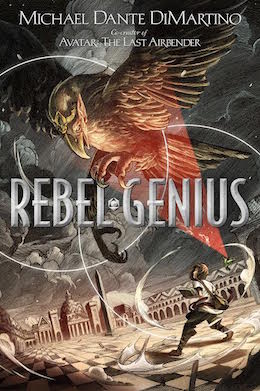Where do you go after co-creating Avatar: The Last Airbender and The Legend of Korra, with young predestined heroes learning to bend the elements? To Zizzola, a fantasy world modeled after the Renaissance, in which young artists unlock the secrets of sacred geometry under the watchful eye of bird-like spirits called Geniuses. Michael Dante DiMartino, who created the aforementioned animated television series with Brian Konietzko over a decade ago, previewed his new book Rebel Genius for Entertainment Weekly—and it shares more than a few similarities with A:TLA and Korra.
The summary from Roaring Book Press describes the overall premise of Rebel Genius:
In twelve-year-old Giacomo’s Renaissance-inspired world, art is powerful, dangerous, and outlawed. A few artists possess Geniuses, birdlike creatures that are the living embodiment of an artist’s creative spirit. Those caught with one face a punishment akin to death, so when Giacomo discovers he has a Genius, he knows he’s in serious trouble.
Luckily, he finds safety in a secret studio where young artists and their Geniuses train in sacred geometry to channel their creative energies as weapons. But when a murderous artist goes after the three Sacred Tools—objects that would allow him to destroy the world and everyone in his path—Giacomo and his friends must risk their lives to stop him.

EW shares more specifics: Giacomo is joined by musician Aaminah, sculptor Savino, and painter Milena; sacred geometry, through which they access their powers, is the belief that every shape has a corresponding number, and is tied to notions such as the golden ratio; and the three Sacred Tools are a Compass, Straightedge, and Pencil. Not surprisingly, the rich world of Rebel Genius is illustrated, from small sketches alongside prose to entire pages that resemble something out of a graphic novel. In addition to sharing art with EW, DiMartino also talked about worldbuilding and characters. For instance, how he came up with the dæmon-like Geniuses…
They didn’t call Da Vinci a genius, they would’ve said he had a genius, or the city had a genius watching over it. Once I hit on that, I was like “oh that’d be cool.” That idea of genius back in the day wasn’t this internalized thing, it was a creature you could see and interact with. I had the idea they would become the artist’s protector and their muse, and they became the channel through which the kids could summon this energy and project it.
…and how—again with the comparison—the Geniuses manifest differently for their young charges:
There’s a practical side, which is that since you’re not gonna see them, you need to associate green light with a certain person or Genius. Thus the idea that these Geniuses have a little bit of their artist in them. Savino’s kind of a tougher kid, so he’s got a cool falcon. Milena, who’s more graceful in her art, has a graceful crane, and Aaminah has a cute fluffball of feathers. Everyone likes animals and creatures, and if you give them specific personalities, people respond to that. Everyone thinks their pet has a personality.
He also discussed the difficulty of distilling Rebel Genius down into a quick pitch like with A:TLA:
With Rebel Genius, I just wrote the book I would’ve been really into as a 12-year-old. As a young artist, I probably would’ve loved it. I liked stuff that was a little challenging and a little bit older than I was. So there’s stuff in the book about the sacred geometry and how that works. That was something where I really had to think about, how can I distill this down into something digestible? I thought a lot about the Guru episode of Avatar, where we were talking about chakras, this very esoteric, complicated subject. People have written many books about them, but we had to distill each one into its essence, and I was trying to do the same thing here with the shapes and numbers. In this book I focused on the first three shapes: the circle, line, and triangle. Then I’ll get into square and hexagon and what those represent, spiritually and to the themes of the book. It definitely gets more complicated.
And if you’re still feeling raw about the ending of Korra, never fear—there’s a graphic novel in the works! DiMartino teased a little bit about the plot:
It’s gonna take place right after the finale, so it’s focusing on Korra and Asami’s relationship as a new threat emerges. It’s kind of like the aftermath dealing with the new portal in the city, and all the evacuees coming back to find their homes wiped out cause of the portal, and Korra has to figure out how to find a new balance in the city with all this stuff that’s gone on.
Read the rest of the interview (and check out the rest of the art) on EW.










